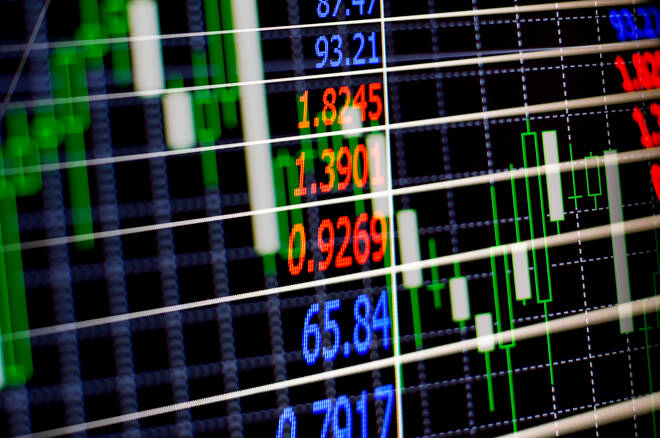Advertisement
Advertisement
The EUR and the Yen See Demand Surge as Risk Aversion Sweeps Across the Global Financial Markets
By:
Risk aversion hits new heights as the coronavirus continues to spread, signaling a dark outlook for the global economy...
Earlier in the Day:
It was a relatively busy day on the Asian economic calendar this morning. The Japanese Yen was in action and for more reason than just the stats
Outside of the numbers, demand for riskier assets hit new heights as the markets responded to news updates on the coronavirus.
Economic data out of China from the weekend set the tone going into the Asian session. China’s trade surplus was wiped out in February, with a 17.2% slide in exports leaving China with a Dollar trade deficit of $7.09bn.
The Italian government’s decision to shut down parts of the country, ultimately quarantining 16m people was a reflection of how dire things have become. In the U.S, cases broke through the 500 mark, which suggests more pain to come.
For the Japanese Yen
GDP numbers out of Japan added to the market angst this morning. According to 2nd estimate figures for the 4th quarter, the economy contracted by 1.8% quarter-on-quarter and by 7.1%, year-on-year. These were downward revisions from 1st estimates.
While the 4th quarter numbers are attributed to typhoons, a sales tax hike, and the U.S – China trade war, expectations are for 1st quarter numbers to show a more material slowdown.
The Japanese Yen moved from ¥103.911 to ¥104.109 upon release of the figures. At the time of writing, the Japanese Yen was up by 2.70% to ¥102.54 against the U.S Dollar.
Elsewhere
At the time of writing, the Aussie Dollar was down by 1.72% to $0.6522, with the Kiwi Dollar down by 1.53%% to $0.6253.
The Day Ahead:
For the EUR
It’s a relatively quiet day ahead on the economic calendar. January German industrial production and trade figures are due out in the early part of the day.
Expect the numbers from Germany to have a muted impact on the EUR, however, as the markets respond to the spread of the coronavirus.
Having seen the effects of the virus on the Chinese economy, expectations are dire for what lies ahead. As Italy looks to contain the spread of the virus, the bigger question is whether the U.S can take similar action…
We continue to see the Dollar suffer, which favors the EUR near-term, with Trump likely to continue to push the FED to slash rates.
Later in the European session, investor confidence figures for the Eurozone will have some influence, however…
At the time of writing, the EUR was up by 1.19% at $1.1418.
For the Pound
It’s another particularly quiet day ahead on the economic calendar, with no material stats due out of the UK to provide direction.
A lack of stats will leave the markets to consider monetary policy and how far the British government will go in its autumn budget.
Economic data has suggested that the BoE can stand pat this month on the policy front, while the government is expected to loosen the purse strings. Wednesday’s stats will influence the outlook on the monetary policy front.
With Brexit negotiations underway, any updates from the EU and the UK on talks will also influence. We will expect some resilience in the Pound, however.
At the time of writing, the Pound was up by 0.21% to $1.3075.
Across the Pond
It’s a quiet day ahead on the U.S economic calendar. There are no material stats due out of the U.S later today.
The Dollar is under the cosh early in the day. The spread of the virus in the U.S has led to a tumble in 10-year Treasury yields. As cases exceed 500 and the number of deaths rises, there is the view that the U.S has yet to fully quantify the number of cases.
With China’s economy in the doldrums, the U.S economy may well follow, which has continued to weigh on the Greenback.
The Dollar Spot Index was down by 0.80% to 95.183 at the time of writing.
For the Loonie
It’s a relatively quiet day ahead on the economic calendar. Key stats due out later today include February housing start and January building permit numbers.
We can expect the Loonie to brush aside the numbers, however. Crude oil prices have fallen to levels last seen back in 2016, adding early pressure. WTI was down by a whopping 31.01% this morning alone…
The IEA’s monthly report due out later today is unlikely to provide too much support. Key for crude oil prices will be a Russia – OPEC agreement on output levels to restore price stability. Even Russia will struggle with sub-$30 per barrel price levels.
The Loonie was down by 1.69% at C$1.3645 against the U.S Dollar, at the time of writing.
About the Author
Bob Masonauthor
With over 28 years of experience in the financial industry, Bob has worked with various global rating agencies and multinational banks. Currently he is covering currencies, commodities, alternative asset classes and global equities, focusing mostly on European and Asian markets.
Advertisement
